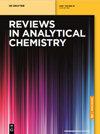利用特异性表位和定向多种抗原肽抗体检测各种生物体液中的外泌体
IF 3.8
3区 化学
Q2 CHEMISTRY, ANALYTICAL
引用次数: 1
摘要
外泌体是纳米大小的细胞来源的囊泡,由于在这些囊泡中遇到的生物分子与特定疾病(包括免疫炎症、心血管和肝脏疾病)直接相关,最近作为一种生物标志物而受到关注。此外,由于它们的纳米尺寸和在细胞外液中的安全旅行,外泌体已被研究作为天然药物递送系统,以优异的特异性和效率将货物运送到目标细胞,并穿过血脑屏障。这就需要分离和检测外泌体。然而,许多外泌体分离技术是可用的,包括超离心、基于尺寸的色谱、聚合物沉淀、微流体和基于免疫亲和的分离,其缺点是非特异性和低成本效益。本文介绍了一种基于免疫亲和的检测外泌体的方法,使用靶向抗外泌体抗体在鸡中饲养,因为它具有经济和商业可行性。目前的研究的独特之处在于,它确定了外泌体表面四跨蛋白(CD9, CD63, CD81)的特定抗原区域,并构建了一个多抗原肽树突状结构,用于在不使用载体蛋白的情况下制造小肽作为免疫原。抗原区选择对研究至关重要,因为它决定了抗体捕获外泌体的效率。该技术在各种生物液体(如血清、尿液、牛奶、血浆和血液)中使用酶联免疫吸附试验进行了验证,因为它具有许多优点,包括高灵敏度、特异性、一次处理多个样品、需要少量样品以及作为抗原无需纯化。鉴于这一技术,它是一个有用的工具,临床监测病人的生物条件。图形抽象本文章由计算机程序翻译,如有差异,请以英文原文为准。
Detection of exosomes in various biological fluids utilizing specific epitopes and directed multiple antigenic peptide antibodies
Abstract Exosomes are nanosized cell-derived vesicles that have recently gained attention for their use as a biomarker since the biomolecules encountered in these vesicles are directly linked to specific diseases including immuno-inflammatory, cardiovascular, and hepatic disorders. Furthermore, due to their nano size and safe travel in extracellular fluids, exosomes have been investigated as natural drug delivery systems, delivering cargo to destined cells with excellent specificity and efficiency, and crossing the blood–brain barrier. This necessitates the isolation and detection of exosomes. However, numerous exosome isolation techniques are available, including ultracentrifugation, size-based chromatography, polymer precipitation, microfluidics, and immunoaffinity-based isolation, with the downfalls of non-specificity and lower cost-effectiveness. This article introduces an immunoaffinity-based detection of exosomes using targeted anti-exosome antibodies raised in chickens due to its economic and commercial viability. The current study is unique in that it identified a specific antigenic region on exosomal surface tetraspanins (CD9, CD63, CD81) and constructed a multiple antigenic peptide dendrimer for making a small peptide as an immunogen without the use of a carrier protein. The antigenic region selection is critical to the study because it determines the efficiency of antibodies for exosome capture. This technique was validated using enzyme-linked immunosorbent assay in various biological fluids such as serum, urine, milk, plasma, and blood due to its numerous advantages including high sensitivity, specificity, handling multiple samples at once, requiring a small sample amount, and no purification as an antigen. In light of this technique, it is a useful tool for clinical monitoring of the patient’s biological conditions. Graphical abstract
求助全文
通过发布文献求助,成功后即可免费获取论文全文。
去求助
来源期刊

Reviews in Analytical Chemistry
化学-分析化学
CiteScore
7.50
自引率
0.00%
发文量
15
审稿时长
>12 weeks
期刊介绍:
Reviews in Analytical Chemistry publishes authoritative reviews by leading experts in the dynamic field of chemical analysis. The subjects can encompass all branches of modern analytical chemistry such as spectroscopy, chromatography, mass spectrometry, electrochemistry and trace analysis and their applications to areas such as environmental control, pharmaceutical industry, automation and other relevant areas. Review articles bring the expert up to date in a concise manner and provide researchers an overview of new techniques and methods.
 求助内容:
求助内容: 应助结果提醒方式:
应助结果提醒方式:


